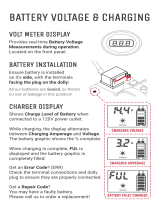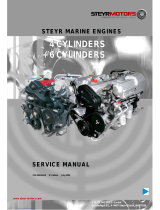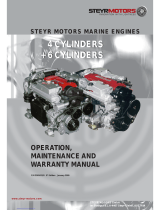
12
60706-236/H
Repeat cycle if necessary.
6. When the engine starts, release the key switch,
allowing it to return to the “on” position.
7. Gradually push the choke to the open position as the
engine warms up.
8. The engine should promptly come up to operating
speed.
CAUTION: EQUIPMENT DAMAGE
Never permit the choke to remain on after the engine
has run for a short time. It is not necessary to choke the
engine when it is warm. Avoid over-chocking.
LP/NG
1. Check oil level, refill as needed.
2. Turn on the LP/NG fuel supply.
3. NEVER use the choke when operating on LP/NG.
4. Turn the engine switch to the ‘on’ position.
5. Operating the starter. Rotate the key switch briefly to
START position. The starter life is improved by using
shorter starting cycles with time to cool off between
cranking cycles. Do NOT operate the starter more
than 5 seconds and wait at least 10 seconds before
operating the starter again. Repeat cycle if necessary.
6. When the engine starts, release the key switch,
allowing it to return to the ‘on’ position.
7. The engine should promptly come up to operating
speed.
11
13240-11 60706-236
LP/NG STARTING
&KHFNRLOOHYHOUH¿OODVQHHGHG
2. Turn on the LP/NG fuel supply
3. NEVER USE THE CHOKE WHEN OPERATING
ON LP/NG..
4. Turn the engine switch to the “on” position
5.. Operating the starter. Rotate the key switch
EULHÀ\WRWKH67$57SRVLWLRQ7KHVWDUWHUOLIHLV
improved by using shorter starting cycles with
time to cool off between cranking cycles. Do
not operate the starter more than 5 seconds and
wait at least 10 seconds before operating the
starter again, Repeat cycle if necessary.
6. When the engine starts, release the key
switch, allowing it to return to the “on” position.
7. The engine should promptly come up to
operating speed.
STARTING HINTS
1. Cold weather
a. Use the proper oil for the temperature
expected.
b. Use fresh winter grade fuel. Winter grade
gasoline is blended to improve starting. Do
not use summer grade gasoline.
2. Hot weather
a. Use the proper oil for the temperature
expected.
b. Use only summer blended gasoline. Using
gasoline left over from winter may cause the
unit to vapor lock.
STOPPING AND STORAGE
1. Move the key switch to the “OFF” position.
2. Turn off the fuel supply valve.
3. Before extended storage (over 30 days) certain
precautions must be taken to ensure the fuel
doesn’t deteriorate and clog the fuel system.
Note: The use of a fuel additive, such a STA-BIL or
equivalent will minimize the formation of gum depos-
its during storage. The additive may be added to
gasoline in the engines fuel tank or to gasoline in a
storage container.
a. Add the fuel stabilizer to the fuel in the tank
and run the unit for 2 minutes to circulate the
stabilizer throughout the fuel system.
b. If you choose to remove the remaining fuel
from the fuel tank, it must be drained into an
approved container.
c. Start the engine and allow it to run until all
the fuel in the carburetor and the fuel lines
has been used up and the engine stops.
Note: Running the engine to use up the fuel in the
lines and carburetor will still leave a small amount of
fuel in the carburetor. It is best for extended storage
to treat the fuel before draining.
d. While the engine is warm, drain the oil and
UH¿OOZLWKIUHVKRLO
e. Clean dirt and chaff from cylinder, cylinder
KHDG¿QVEORZHUKRXVLQJVFUHHQDQG
PXIÀHUDUHDV
f. Store in a clean and dry area.
OPERATING SPEED
The engine-generator must be run at the correct
speed in order to produce the proper electrical volt-
age and frequency.
CAUTION: EQUIPMENT DAMAGE
The output voltage should be checked to ensure
the generator is working properly prior to connecting
a load to the generator. Failure to do so could result
in damage to equipment plugged into the unit and
possible injury to the individual.
ENGINE
SWITCH
O
ONN
O
ONN
Turn the engine switch to
the ON position.
START
ENGINE
SWITCH
O
ONN
11
13240-11 60706-236
LP/NG STARTING
&KHFNRLOOHYHOUH¿OODVQHHGHG
2. Turn on the LP/NG fuel supply
3. NEVER USE THE CHOKE WHEN OPERATING
ON LP/NG..
4. Turn the engine switch to the “on” position
5.. Operating the starter. Rotate the key switch
EULHÀ\WRWKH67$57SRVLWLRQ7KHVWDUWHUOLIHLV
improved by using shorter starting cycles with
time to cool off between cranking cycles. Do
not operate the starter more than 5 seconds and
wait at least 10 seconds before operating the
starter again, Repeat cycle if necessary.
6. When the engine starts, release the key
switch, allowing it to return to the “on” position.
7. The engine should promptly come up to
operating speed.
STARTING HINTS
1. Cold weather
a. Use the proper oil for the temperature
expected.
b. Use fresh winter grade fuel. Winter grade
gasoline is blended to improve starting. Do
not use summer grade gasoline.
2. Hot weather
a. Use the proper oil for the temperature
expected.
b. Use only summer blended gasoline. Using
gasoline left over from winter may cause the
unit to vapor lock.
STOPPING AND STORAGE
1. Move the key switch to the “OFF” position.
2. Turn off the fuel supply valve.
3. Before extended storage (over 30 days) certain
precautions must be taken to ensure the fuel
doesn’t deteriorate and clog the fuel system.
Note: The use of a fuel additive, such a STA-BIL or
equivalent will minimize the formation of gum depos-
its during storage. The additive may be added to
gasoline in the engines fuel tank or to gasoline in a
storage container.
a. Add the fuel stabilizer to the fuel in the tank
and run the unit for 2 minutes to circulate the
stabilizer throughout the fuel system.
b. If you choose to remove the remaining fuel
from the fuel tank, it must be drained into an
approved container.
c. Start the engine and allow it to run until all
the fuel in the carburetor and the fuel lines
has been used up and the engine stops.
Note: Running the engine to use up the fuel in the
lines and carburetor will still leave a small amount of
fuel in the carburetor. It is best for extended storage
to treat the fuel before draining.
d. While the engine is warm, drain the oil and
UH¿OOZLWKIUHVKRLO
e. Clean dirt and chaff from cylinder, cylinder
KHDG¿QVEORZHUKRXVLQJVFUHHQDQG
PXIÀHUDUHDV
f. Store in a clean and dry area.
OPERATING SPEED
The engine-generator must be run at the correct
speed in order to produce the proper electrical volt-
age and frequency.
CAUTION: EQUIPMENT DAMAGE
The output voltage should be checked to ensure
the generator is working properly prior to connecting
a load to the generator. Failure to do so could result
in damage to equipment plugged into the unit and
possible injury to the individual.
ENGINE
SWITCH
O
ONN
O
ONN
START
ENGINE
SWITCH
O
ONN
INITIAL START UP
The throttle control on these generators is preset and
locked to operate at 3600 RPM (nominal) with no load
speed set at 3690 RPM. Only a trained service technician
should be allowed to adjust this speed setting.
NOTICE: ENGINE START LOCKOUT
This unit will not start if it is low on oil. The lubricating
oil level must be at the full mark before the engine will
start and run.
BASIC OPERATION
If the engine is cold and stiff or if the battery is not fully
charged, starting can be made easier by slowly hand
cranking the engine through the compression stroke before
pushing the starter switch. This permits the starter to gain
momentum before the heavy load of the compression
stroke occurs. This minimizes the drain on the battery and
improves the possibility of starting under such adverse
conditions. Always keep the battery charged, especially
during cold weather operation.
GASOLINE
1. Check oil level, refill as needed.
2. Turn on the fuel supply. Ref “A”. Lever pointing up or
down is on, lever sideways is off.
3. Pull the choke out to the full “closed” position. A
warm engine will require less chocking than a cold
engine.
4. Turn the engine switch to the “on” position.
5. Operating the starter. Rotate the key
switch briefly to the START position.
The starter life is improved by using
shorter starting cycles with time to cool
off between cranking cycles. Do not
operate the starter more than 5
seconds and wait at least 10 seconds
before operating the starter again.
7
2015-00 60706-233
For your safety always connect the positive battery
cable to the “bat+” terminal first. Then connect the
negative battery cable to the “bat-” terminal. Make
sure all connections are clean and tight. Reverse
the sequence when disconnecting, disconnect the
negative cable first. These engines produce enough
direct current to keep a battery charged under nor-
mal operating conditions, but were not intended to
be used as a battery charger.
WARNING: PERSONAL INJURY
Lead acid batteries produce explosive hydrogen
gas when charging. Keep sparks, flames, and
burning cigarettes away from the battery. Ventilate
the area when charging or using the battery in an
enclosed space. Lead acid batteries contain sulfuric
acid, which causes severe burns. If acid contacts
eyes, skin or clothing, flush well with water. For con-
tact with eyes, get immediate medical attention.
BATTERY CHARGING
Units equipped with electric start have a small fly-
wheel charger built into the engine flywheel assem-
bly for recharging the starting battery. This flywheel
charger generates a small AC current that passes
through a diode assembly to produce a DC charg-
ing current of about 1 to 3 AMPS. This circuit is not
designed to be used as a battery charging circuit to
recharge dead batteries.
OPTIONAL DOLLY KIT
An optional dolly kit is available for this generator.
The dolly kit comes with instructions and parts list.
After installing the dolly kit, file the instructions and
parts list in the back of this manual for future refer-
ence.
OIL ALERT SYSTEM
This WINCO Industrial generator is equipped with a
low oil shutdown system. This Honda engine uses
an float switch mounted inside the engine. If the oil
level drops below a certain point the low oil module
on the engine will shut it down. This low oil warning
system will automatically stop the engine before the
oil level reaches a critical danger point. This feature
is designed to prevent costly repairs and downtime.
CAUTION: EQUIPMENT DAMAGE
Allowing the engine to shutdown repeatedly on
low oil level may cause excessive wear which can
be cumulative.
INITIAL START UP
The throttle control on these generators is preset
and locked to operate at 3600 RPM (nominal) with
no load speed set at 3690 RPM. Only a trained
service technician should be allowed to adjust this
speed setting.
NOTICE: ENGINE START LOCKOUT
This unit will not start if it is low on oil. The lu-
bricating oil level must be at the full mark before the
engine will start and run.
BASIC OPERATION
ELECTRIC STARTING
If the engine is cold and stiff or if the battery is not
fully charged, starting can be made easier by slowly
hand cranking the engine through the compres-
sion stroke before pushing the starter switch. This
permits the starter to gain momentum before the
heavy load of the compression stroke occurs. This
minimizes the drain on the battery and improves the
possibility of starting under such adverse conditions.
Always keep the battery charged, especially during
cold weather operation.
1. Check oil level, refill as needed
2. Turn on the fuel supply. Ref “A” Lever pointing
up is on, lever pointing down is off.
A
ENGLISH
STOPPING THE ENGINE
MMMIIINNN...
MMMIIINNN...
START
ENGINE
SWITCH
START
ENGINE
SWITCH
THROTTLE LEVER
OOONNN
CHOKE KNOB
O
OP
PE
EN
N
C
CL
LO
OS
SE
ED
D
OOONNN
OOONNN
MMMIIINNN...
MMMIIINNN...
THROTTLE LEVER
ENGINE SWITCH
OFF
OFF
5
Some engine applications use a remote-mounted throttle control
rather than the engine-mounted throttle lever shown here. Refer to
the instructions provided by the equipment manufacturer.
Turn the engine switch to
the ON position.
Operate the starter.
Turn the engine switch to the START
position, and hold it there until the
engine starts.
If the engine fails to start within 5
seconds, release the engine switch,
and wait at least 10 seconds before
operating the starter again.
Using the electric starter for more than
5 seconds at a time will overheat the
starter motor and can damage it.
When the engine starts, release the
engine switch, allowing it to return
to the ON position.
Move the throttle lever away from the MIN. position, about 1/3
of the way toward the MAX. position.
Warm up the engine for 2 or 3 minutes.
If the choke knob was pulled to the CLOSED position to start the
engine, gradually push it to the OPEN position as the engine
warms up.
To stop the engine in an emergency, simply turn the engine switch
to the OFF position. Under normal conditions, use the following
procedure. Refer to the instructions provided by the equipment
manufacturer.
Move the throttle lever to the MIN. position.
Some engine applications use a remote-mounted throttle
control rather than the engine-mounted throttle lever shown
here.
Turn the engine switch to the OFF position.
If the fuel tank is equipped with a valve, turn the fuel valve to the
CLOSED or OFF position.
3.
4.
5.
6.
7.
3.
1.
2.
09/07/07 20:33:44 32Z6L600_005
ENGLISH
STOPPING THE ENGINE
MMMIIINNN...
MMMIIINNN...
START
ENGINE
SWITCH
START
ENGINE
SWITCH
O
ON
N
CHOKE KNOB
OOOPPPEEENNN
CCCLLLOOOSSSEEEDDD
O
ON
N
OOONNN
MMMIIINNN...
MMMIIINNN...
THROTTLE LEVER
ENGINE SWITCH
OFF
OFF
5
Some engine applications use a remote-mounted throttle control
rather than the engine-mounted throttle lever shown here. Refer to
the instructions provided by the equipment manufacturer.
Turn the engine switch to
the ON position.
Operate the starter.
Turn the engine switch to the START
position, and hold it there until the
engine starts.
If the engine fails to start within 5
seconds, release the engine switch,
and wait at least 10 seconds before
operating the starter again.
Using the electric starter for more than
5 seconds at a time will overheat the
starter motor and can damage it.
When the engine starts, release the
engine switch, allowing it to return
to the ON position.
Move the throttle lever away from the MIN. position, about 1/3
of the way toward the MAX. position.
Warm up the engine for 2 or 3 minutes.
If the choke knob was pulled to the CLOSED position to start the
engine, gradually push it to the OPEN position as the engine
warms up.
To stop the engine in an emergency, simply turn the engine switch
to the OFF position. Under normal conditions, use the following
procedure. Refer to the instructions provided by the equipment
manufacturer.
Move the throttle lever to the MIN. position.
Some engine applications use a remote-mounted throttle
control rather than the engine-mounted throttle lever shown
here.
Turn the engine switch to the OFF position.
If the fuel tank is equipped with a valve, turn the fuel valve to the
CLOSED or OFF position.
3.
4.
5.
6.
7.
3.
1.
2.
09/07/07 20:33:44 32Z6L600_005
ENGLISH
STOPPING THE ENGINE
MMMIIINNN...
MMMIIINNN...
START
ENGINE
SWITCH
START
ENGINE
SWITCH
THROTTLE LEVER
OOONNN
CHOKE KNOB
OOOPPPEEENNN
CCCLLLOOOSSSEEEDDD
OOONNN
O
ON
N
MMMIIINNN...
MMMIIINNN...
THROTTLE LEVER
ENGINE SWITCH
OFF
OFF
5
Some engine applications use a remote-mounted throttle control
rather than the engine-mounted throttle lever shown here. Refer to
the instructions provided by the equipment manufacturer.
Turn the engine switch to
the ON position.
Operate the starter.
Turn the engine switch to the START
position, and hold it there until the
engine starts.
If the engine fails to start within 5
seconds, release the engine switch,
and wait at least 10 seconds before
operating the starter again.
Using the electric starter for more than
5 seconds at a time will overheat the
starter motor and can damage it.
When the engine starts, release the
engine switch, allowing it to return
to the ON position.
Move the throttle lever away from the MIN. position, about 1/3
of the way toward the MAX. position.
Warm up the engine for 2 or 3 minutes.
If the choke knob was pulled to the CLOSED position to start the
engine, gradually push it to the OPEN position as the engine
warms up.
To stop the engine in an emergency, simply turn the engine switch
to the OFF position. Under normal conditions, use the following
procedure. Refer to the instructions provided by the equipment
manufacturer.
Move the throttle lever to the MIN. position.
Some engine applications use a remote-mounted throttle
control rather than the engine-mounted throttle lever shown
here.
Turn the engine switch to the OFF position.
If the fuel tank is equipped with a valve, turn the fuel valve to the
CLOSED or OFF position.
3.
4.
5.
6.
7.
3.
1.
2.
09/07/07 20:33:44 32Z6L600_005

























